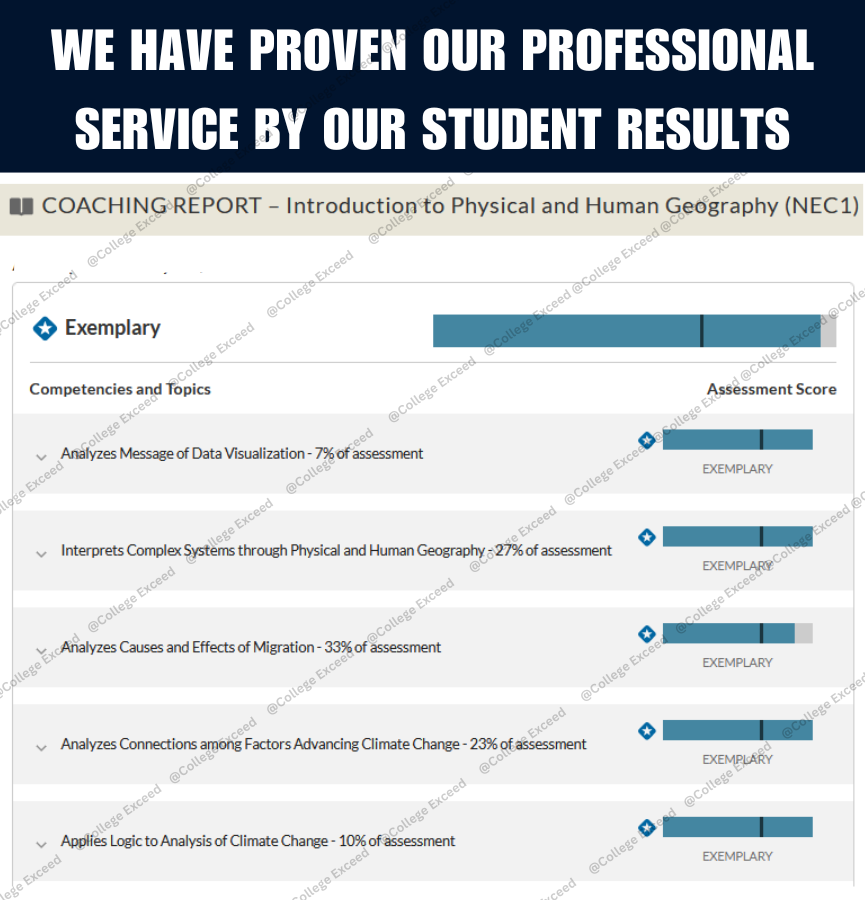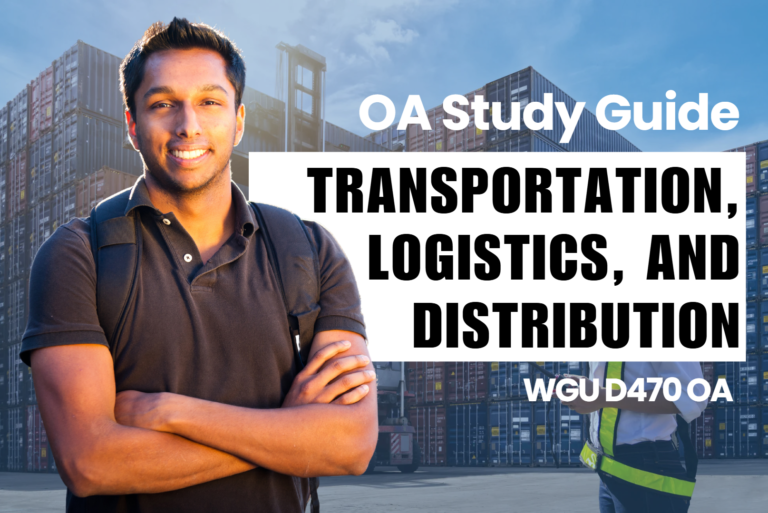Greetings, WGU students! Welcome to our guide on mastering Introduction to Physical and Human Geography WGU D199 OA. As you embark on your academic journey, this module may seem like a formidable challenge. But fret not! You’re in good company – many students have walked this path before you and emerged victorious.
In this article, we’ll be your trusted companions, helping you navigate through the complexities of this course with ease. Together, we’ll explore:
- An overview of what to expect in the Introduction to Physical and Human Geography WGU D199 module
- Tips and strategies for acing both the Objective Assessment and the Pre-assessment
- A detailed study guide designed to steer you toward success in module D199
- Key topics to focus your attention on
- Recommended external resources to enhance your understanding
So, let’s embark on this adventure together! With our guidance and support, you’ll be well-equipped to excel in this module. Best of luck on your journey!
...
About Introduction to Physical and Human Geography WGU D199 📖
In Introduction to Physical and Human Geography, WGU D199, you will embark on an enlightening exploration of our planet’s diverse landscapes and the dynamic interactions between the natural environment and human societies. The course covers a wide array of captivating topics, such as:
Physical Geography: Students will learn the physical processes of the planet, among others the plate tectonics, erosion of the rocks, and the creation of the land such mountains, rivers and coastlines.
Climatology: Students will discuss with weather and climate patterns involved. They explain influences by the temperature, precipitation, atmosphere circulation, and climate zones around the world.
Biogeography: During ecological systems and biodiversity exploration, which includes distribution of plant and animal species, interdependent ecological connections, and negative human impacts on the natural surroundings, students will gain knowledge.
Human Geography: By redirection towards human activities and cultural sceneries, students will evaluate population dynamics, migration patterns, urbanization, economic activities, cultural and social composition in the world.
Geospatial Technologies: Students will also discuss applications of geospatial technologies like GIS (Geographic Information Systems) and remote sensing for the analysis of spatial data including for spatial patterns creation.
By immersing yourself in these engaging topics, you will gain a deeper understanding of the complex relationships between the Earth’s physical processes and human societies. This module serves as a foundational stepping stone for further exploration in geography and related fields, providing students with valuable insights into the dynamic forces shaping our planet.
In D199 you will navigate through three comprehensive sections comprising a total of eleven enriching topics. Here’s a glimpse at what awaits:
Section 1: What is Geography?
Section 2: Pattern of Migration
Section 3: Global Climate Change
Lesson 1: Messages of Visual Representations
Lesson 2: Purposes and Significance of Visual Representations
Lesson 3: Manipulating Data
Lesson 4: Differentiating Physical and Human Geography
Lesson 5: Physical Geography and Ecological Systems
Lesson 6: Physical Geography and Economic Systems
Lesson 7: Physical Geography and Political Systems
Lesson 8: Human Geography and Ecological Systems
Lesson 9: Human Geography and Economic Systems
Lesson 10: Human Geography and Political Systems
Lesson 11: The Relationship between Physical and Human Geography
Considering the extensive scope of topics in this module, it tends to lean more towards theoretical concepts. Thus, it may demand a bit more time and dedication from you compared to other courses. However, don’t be discouraged! With your dedication and effective study strategies, you’ll confidently tackle these concepts and achieve success in the course.
...
Tips and strategies to overcome the Pre-A and OA📝
As mentioned earlier, the assessments in this module are often considered challenging. Given the heavy course content, success requires a strong grasp and memorization of each topic. Let’s delve into what you can expect from both the Pre-Assessment and the Objective Assessment (OA) of this module, along with some valuable tips and tricks to help you excel.
The Pre-A and the OA you will face will be similar in structure;
- Number of Questions: 60
- Time Allocated : 120 minutes (2 hours)
- Venue : Online (OA will be proctored)
- Question Type : MCQ
- Other Information : Closed book exam. You will be allowed to bring a whiteboard for taking notes during the assessment
Even though the assessments share a similar structure, they differ significantly in other aspects. Former course takers note that the questions in the Pre-Assessment of D199 are worded differently and tend to be more challenging compared to those in the Objective Assessment (OA). Despite this, attempting the Pre-Assessment before the OA is crucial as it allows you to validate your understanding of the course content.
Another important aspect to consider during your studies in this module is avoiding the trap of trying to memorize key terms and definitions. The assessment questions are designed in a way that requires you to apply the concepts you’ve learned to real-life scenarios rather than simply recalling information. Therefore, your main focus should be on comprehending the concepts of the module and understanding how to apply them effectively. It may be necessary to review the course material multiple times to gain a clear understanding of each topic. Though this can be frustrating, it is the most effective approach to excel in your final assessments.
As you progress through your studies, ensure to prioritize the following topics. These areas will be particularly significant when you tackle the OA of this module.
- Reading maps and graphs
- Types of states (ex. Urinary, federal, multinational)
- Ecosystem and how it works
- Industrial Revolution and the changes it brought
- How HDI, GDP, is measured
- Definitions of harmony and Hegemony
- Types of migrations
- Real-world scenarios in specific countries (Palestine, Israel, India etc.)
- Kyoto Protocol, Paris Agreement and Montreal Protocol
- Smart grid vs electric grid
- Photosynthesis
- Carbon sequestration
- Deforestation and land use
- Global north vs global south
While attempting the assessments, utilizing the whiteboard can be advantageous. Once the assessment begins, take advantage of the whiteboard to jot down any crucial information you’ve memorized just before the assessment. Additionally, you can use it to note down significant keywords in the questions, as assessment questions often try to mislead you with their wording.
Another valuable strategy is to employ the elimination method when answering multiple-choice questions. If you’re unsure of an answer, rather than guessing, try eliminating the incorrect options. This can narrow down the correct answer to at least two choices, increasing your chances of guessing correctly. If you’re still struggling, consider bookmarking the question to revisit it later after attempting other questions.
By employing these tips and tricks to your advantage, you can gain an edge in both the Pre-Assessment and the Objective Assessment (OA), greatly enhancing your chances of success.
Study Guide for Introduction to Physical and Human Geography WGU D199📝
Now, let’s address the most pressing question in this module: What is the most effective way to study the course material and achieve your best? If you keep reading, below you’ll discover our meticulously crafted step-by-step study plan designed to accommodate individuals of all knowledge levels. Regardless of your background, following our study guide will set you on the path to success in this module. We’ve meticulously prepared this guide through extensive research into the module and by gathering feedback from former WGU coursetakers.
Whether you choose to adhere to each step precisely as outlined or prefer to glean tips and tricks to create your own study plan is entirely up to you. So, cast aside your worries, and allow us to guide you along the right path.
Step 1 – Go through the ETextBook provided by WGU
No surprises here – our first recommendation for the D199 module is the obvious choice: the eTextbook provided by WGU. There’s simply no other resource out there that will better equip you for success. Unlike other resources, this book provides precisely the knowledge you need to pass the Objective Assessment (OA), without leading you astray into unnecessary information. This is crucial given the substantial course content you’ll need to cover. However, instead of diving into the book blindly, allow us to offer some helpful tips to make your study experience more manageable.
Download the Section Roadmaps (Note-taking guides)
You can locate these documents in the “Course Search” section of the module. Navigate to the 3rd page and download all three files from the “Section Roadmaps (Note-taking guides)” link. These files provide an overview of each topic and offer space for you to take notes during your studies.
Use the Interactive Study Guide
Utilize the Interactive Study Guide, also available in the same location as the previous files. Navigate to the “Course Search” and go to the 2nd page to find the link for the “Interactive Study Guide”. This guide serves as a supplementary resource to help you grasp key concepts. Additionally, you’ll find informative videos within this guide, aiding visual memorization of important information. Going through this interactive study guide is essential for any student tackling D199.
If you need further resources to aid in understanding these topics, you can utilize the YouTube CrashCourse videos listed in the “External Resources” section of this article.
Step 2 – Attend Live Cohorts and communicate with your course instructor
Given that this module is relatively new at WGU, it’s highly advisable to participate in the live cohorts scheduled regularly. Unlike studying with guides and books alone, joining live cohorts provides you with the opportunity to receive information from an expert in the field. It also allows you to ask questions and clarify any doubts you may have regarding the course content. We cannot emphasize enough how crucial it is to attend as many cohorts as possible for success in D199. Keep an eye out for the timetable of live cohorts posted by course instructors and register as soon as they are available to ensure you don’t miss out.
Once you’ve completed your initial review of the course content, we recommend scheduling a call with your course instructor to discuss your progress and seek advice on evaluating your current knowledge. Former students of D199 have informed us that course instructors possess many valuable additional resources for studying the course content, which can greatly benefit you in the long run. Therefore, be sure to ask them for these resources to ensure you are best prepared for the Objective Assessment (OA)
Step 3 – Revise the course content and attempt quizzlets and practice questions
This is a crucial aspect of our study plan, so be sure not to skip it. While revising the course content may seem daunting due to its volume, it is essential before attempting the upcoming assessments. If time permits, we strongly recommend going through the eTextbook once again from start to finish. Reviewing the topics a second time will help solidify the information in your mind.
If time is limited and you’re unable to go through the entire book again, we suggest reading the summary of each topic and completing the quizzes at the end of each lesson. It’s important to cover all 11 lessons to ensure there are no gaps in your knowledge.
Once you’ve revisited the course content, participate in the quizzlets listed in our “External Resources” section of the article. These quizzlets will reinforce key concepts in your memory. Additionally, if your course instructor has provided any practice questions, now is the ideal time to attempt them.
Step 4 – Attempt the Pre-A
Now that you’ve completed steps 1 through 3, it’s time to assess your knowledge by taking the Introduction to Physical and Human Geography WGU D199 Pre-Assessment. It’s crucial that you approach the Pre-Assessment as if it were a real exam to obtain an accurate estimate of your knowledge. This is the final tool we’ll be using to prepare before attempting the Objective Assessment (OA) of D199. So, follow the steps below and give it your best effort.
- Find a quiet and comfortable place where you can focus and avoid distractions.
- Set aside at least two hours to complete the Pre-A
- Go to the D199 module page and start the Pre-A
- Use common sense and logic to answer the questions, not just memorization.
Step 5 – Go through the coaching guide of the Pre-A
After completing the Pre-Assessment, an auto-generated coaching guide will be provided to you. This guide visualizes your knowledge in each topic and helps you understand where you may lack proficiency. Use this guide to identify your weaknesses and revisit the topics where you scored the lowest. If you did not pass the Pre-Assessment on your first attempt, consider retaking it. Repeat this process until you achieve a passing score.
Step 6 – Attempt the OA
Now, you’re prepared to tackle the biggest challenge in your journey: the final assessment. The OA of D199 is generally considered easier than the Pre-Assessment. Therefore, now that you’ve passed the OA, it should be a manageable task for you. However, it’s important not to let your guard down. Be prepared to give your best effort on the OA, as this will be the final hurdle you face in this module.
To take the OA,
- Schedule the OA at a convenient time and date for you
- Make sure you have a stable internet connection, a webcam, and a microphone.
- Follow the proctoring instructions and rules carefully.
- Use the same strategies and skills that you used for the Pre-A
- Relax and be confident in your abilities.
Best of Luck!!
...
...
...
Conclusion 📄
In wrapping up, we hope the information shared here will be a valuable asset as you tackle Introduction to Physical and Human Geography, WGU D199. Our aim is to see you succeed, and we’re confident that by following the study guide provided and making use of the recommended external resources, you’ll be well-prepared to excel in the Objective Assessment (OA). As you dive into your studies, remember that it’s okay to ask questions and seek help when needed. Your dedication and effort will surely pay off!
Wishing you the very best in your academic journey. May you approach each challenge with enthusiasm and emerge victorious. Good luck!







